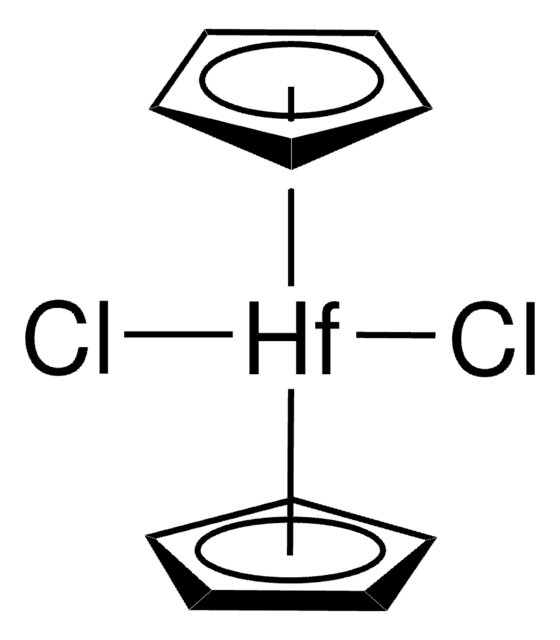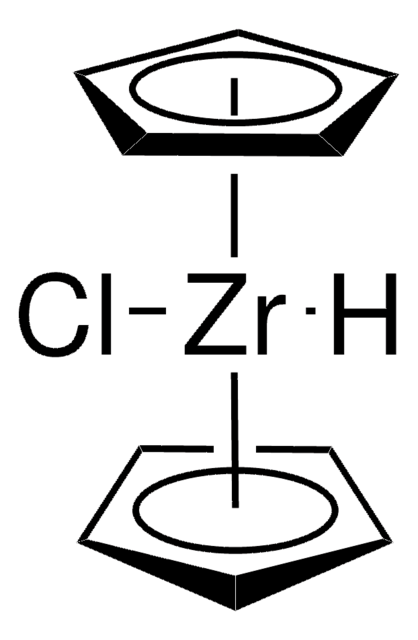If this product has an expiration or retest date, it will be shown on the Certificate of Analysis (COA, CofA). If there is no retest or expiration date listed on the product's COA, we do not have suitable stability data to determine a shelf life. For these products, the only date on the COA will be the release date; a retest, expiration, or use-by-date will not be displayed.
For all products, we recommend handling per defined conditions as printed in our product literature and website product descriptions. We recommend that products should be routinely inspected by customers to ensure they perform as expected.
For products without retest or expiration dates, our standard warranty of 1 year from the date of shipment is applicable.
For more information, please refer to the Product Dating Information document: https://www.sigmaaldrich.com/deepweb/assets/sigmaaldrich/marketing/global/documents/449/386/product-dating-information-mk.pdf
Kluczowe dokumenty
196215
Bis(cyclopentadienyl)zirconium(IV) dichloride
≥98%
Synonim(y):
Dichlorek dicyklopentadienu cyrkonu, Dichlorodicyklopentadienylocyrkon, Dichlorozirkonocen
Wybierz wielkość
176,00 zł
Wybierz wielkość
About This Item
176,00 zł
Polecane produkty
Poziom jakości
Próba
≥98%
Formularz
solid
przydatność reakcji
core: zirconium
reaction type: Polymerization Reactions
reagent type: catalyst
reaction type: Olefin Metathesis
charakterystyka ekologicznej alternatywy
Catalysis
Learn more about the Principles of Green Chemistry.
sustainability
Greener Alternative Product
Parametry
moisture sensitive
mp
242-245 °C (lit.)
kategoria ekologicznej alternatywy
, Aligned
temp. przechowywania
2-8°C
ciąg SMILES
Cl[Zr]Cl.[CH]1[CH][CH][CH][CH]1.[CH]2[CH][CH][CH][CH]2
InChI
1S/2C5H5.2ClH.Zr/c2*1-2-4-5-3-1;;;/h2*1-5H;2*1H;/q;;;;+2/p-2
Klucz InChI
QRUYYSPCOGSZGQ-UHFFFAOYSA-L
Szukasz podobnych produktów? Odwiedź Przewodnik dotyczący porównywania produktów
Opis ogólny
Zirconocene dichloride serves as a catalyst, enabling efficient synthesis of pyrrole with high yields and simplifies the purification process economically.[1]
Zastosowanie
Direct amide formation from unactivated carboxylic acids and amines
Hasło ostrzegawcze
Warning
Zwroty wskazujące rodzaj zagrożenia
Zwroty wskazujące środki ostrożności
Klasyfikacja zagrożeń
Eye Irrit. 2 - Skin Irrit. 2 - STOT SE 3
Organy docelowe
Respiratory system
Kod klasy składowania
11 - Combustible Solids
Klasa zagrożenia wodnego (WGK)
WGK 3
Temperatura zapłonu (°F)
Not applicable
Temperatura zapłonu (°C)
Not applicable
Środki ochrony indywidualnej
dust mask type N95 (US), Eyeshields, Gloves
Wybierz jedną z najnowszych wersji:
Certyfikaty analizy (CoA)
Nie widzisz odpowiedniej wersji?
Jeśli potrzebujesz konkretnej wersji, możesz wyszukać konkretny certyfikat według numeru partii lub serii.
Masz już ten produkt?
Dokumenty związane z niedawno zakupionymi produktami zostały zamieszczone w Bibliotece dokumentów.
-
How can I determine the shelf life / expiration / retest date of this product?
1 answer-
Helpful?
-
-
How is shipping temperature determined? And how is it related to the product storage temperature?
1 answer-
Products may be shipped at a different temperature than the recommended long-term storage temperature. If the product quality is sensitive to short-term exposure to conditions other than the recommended long-term storage, it will be shipped on wet or dry-ice. If the product quality is NOT affected by short-term exposure to conditions other than the recommended long-term storage, it will be shipped at ambient temperature. As shipping routes are configured for minimum transit times, shipping at ambient temperature helps control shipping costs for our customers. For more information, please refer to the Storage and Transport Conditions document: https://www.sigmaaldrich.com/deepweb/assets/sigmaaldrich/marketing/global/documents/316/622/storage-transport-conditions-mk.pdf
Helpful?
-
Active Filters
Nasz zespół naukowców ma doświadczenie we wszystkich obszarach badań, w tym w naukach przyrodniczych, materiałoznawstwie, syntezie chemicznej, chromatografii, analityce i wielu innych dziedzinach.
Skontaktuj się z zespołem ds. pomocy technicznej




![Dichloro[rac-ethylenebis(4,5,6,7-tetrahydro-1-indenyl)]zirconium(IV) 97%](/deepweb/assets/sigmaaldrich/product/structures/571/886/f2860a8d-a40a-461c-ba1e-93913a644d32/640/f2860a8d-a40a-461c-ba1e-93913a644d32.png)

![Dichloro[rac-ethylenebis(indenyl)]zirconium(IV)](/deepweb/assets/sigmaaldrich/product/structures/296/699/b249f923-58d9-45b3-bd63-b110942453d3/640/b249f923-58d9-45b3-bd63-b110942453d3.png)


